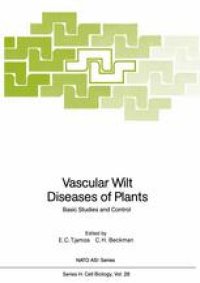
Ebook: Vascular Wilt Diseases of Plants: Basic Studies and Control
- Tags: Agriculture, Forestry, Ecology, Plant Sciences
- Series: NATO ASI Series 28
- Year: 1989
- Publisher: Springer-Verlag Berlin Heidelberg
- Edition: 1
- Language: English
- pdf
It is apparent that wilt diseases continue to be a major problem in crop production because of the number of crops affected, the number and genetic variability of pathogens involved, and their widespread occurrence throughout tropical and temperate regions under a variety of cropping systems. It is also apparent, however, that new understandings and approaches, often in combinations not previously discerned, offer exciting new prospects for research, understanding and practical control methods. The current state-of-the-art and fields for further studies were discussed by researchers actively engaged in a wide range of areas from ecological studies of physical and biological factors in the host-parasite-environmental interactions in the soil, through physiological and biochemical studies of host-parasite recognition and interaction that determine relative colonization of the host, through genetic-molecular studies of these interactions, to the most practical field studies of disease control.
It is apparent that wilt diseases continue to be a major problem in crop production because of the number of crops affected, the number and genetic variability of pathogens involved, and their widespread occurrence throughout tropical and temperate regions under a variety of cropping systems. It is also apparent, however, that new understandings and approaches, often in combinations not previously discerned, offer exciting new prospects for research, understanding and practical control methods. The current state-of-the-art and fields for further studies were discussed by researchers actively engaged in a wide range of areas from ecological studies of physical and biological factors in the host-parasite-environmental interactions in the soil, through physiological and biochemical studies of host-parasite recognition and interaction that determine relative colonization of the host, through genetic-molecular studies of these interactions, to the most practical field studies of disease control.
It is apparent that wilt diseases continue to be a major problem in crop production because of the number of crops affected, the number and genetic variability of pathogens involved, and their widespread occurrence throughout tropical and temperate regions under a variety of cropping systems. It is also apparent, however, that new understandings and approaches, often in combinations not previously discerned, offer exciting new prospects for research, understanding and practical control methods. The current state-of-the-art and fields for further studies were discussed by researchers actively engaged in a wide range of areas from ecological studies of physical and biological factors in the host-parasite-environmental interactions in the soil, through physiological and biochemical studies of host-parasite recognition and interaction that determine relative colonization of the host, through genetic-molecular studies of these interactions, to the most practical field studies of disease control.
Content:
Front Matter....Pages I-XIV
Colonization of the Vascular System of Plants by Fungal Wilt Pathogens: A Basis for Modeling the Interactions between Host and Parasite in Time and Space....Pages 1-17
Host Colonization and Pathogenesis in Plant Diseases Caused by Fastidious Xylem-Inhabiting Bacteria....Pages 19-32
Pathogenesis in Vascular Diseases of Plants....Pages 33-50
Diagnosis of Bacterial Infections by Immunological Methods....Pages 51-94
Current Status of Verticillium Wilt of Cotton in Southern Spain: Pathogen Variation and Population in Soil....Pages 95-105
Sources and Pathways of Contamination of Potatoes by Soft Rot Erwinias in Scotland....Pages 107-111
Recognition and Response between Host and Parasite as Determinants in Resistance and Disease Development....Pages 113-121
Secondary Metabolites Produced in Resistant and Susceptible Host Plants in Response to Fungal Vascular Infection....Pages 123-132
Induced Resistance to Fusarium Wilt Diseases....Pages 133-142
Physiological and Biochemical Mechanisms in Host Resistance and Susceptibility to Wilt Pathogens....Pages 143-151
Fusarium Wilt of Oil Palm: Transmission, Isolate Variation, Resistance....Pages 153-162
Implications of Genetic/Molecular Evidence with Respect to Virulence/Avirulence of Fungal Wilt Pathogens....Pages 163-174
Molecular Bases for Virulence and Avirulence of Fungal Wilt Pathogens....Pages 175-196
Virulence and Avirulence of Bacterial Pathogens and Designation of Races....Pages 197-217
The Analysis of Verticillium Strain Relationship....Pages 219-228
Nutritional Factors Affecting Fusarium Wilt Incidence and Severity....Pages 229-235
Soil Temperature Interactions with the Biotic Components of Vascular Wilt Diseases....Pages 237-246
Microbial Populations and Mechanisms Determining Soil-Suppressiveness to Fusarium Wilts....Pages 247-258
Role of Competition for Carbon and Iron in Mechanisms of Soil Suppressiveness to Fusarium Wilts....Pages 259-275
On the Influence of Environmental Factors on Disease Development....Pages 277-289
Factors Affecting Potato Blackleg Development....Pages 291-302
Problems and Prospects in Controlling Verticillium Wilt....Pages 303-314
Manipulation of Soil Environment to Create Suppressiveness in Soils....Pages 315-323
Biocontrol of Verticillium Wilt of Eggplant and Potato....Pages 325-335
The Biological Control Induced by Soil Solarization....Pages 337-352
Races of Fusarium Oxysporum F. Sp. Ciceri Infecting Chickpeas in Southern Spain....Pages 353-366
Inhibition of Microsclerotium Formation in Verticillium Dahliae by Thioglycolic Acid in Infected Cotton Stems....Pages 367-384
Cultural Practices: The Effect of Plant Density and Irrigation Regimes on Verticillium Wilt of Cotton....Pages 385-396
Preliminary Studies on the Control of Potato Blackleg By a Hot Water Treatment of Seed Tubers....Pages 397-411
Back Matter....Pages 413-420
....Pages 421-431